Effect of Graphene Oxide on the Mechanical Property and Microstructure of Clay-Cement Slurry
Abstract
:1. Introduction
2. Materials and Methods
2.1. Materials
2.1.1. Clay-Cement Slurry
2.1.2. Graphene Oxide
2.2. Methods
2.2.1. Sample Preparation
2.2.2. Testing Procedures
3. Results
3.1. Slurry Injectability
3.1.1. Slurry Rheology
3.1.2. Slurry Bleeding Rate
3.2. Slurry Strength
3.2.1. Plastic Strength of Slurry
3.2.2. Yield Strength of Slurry
3.2.3. Uniaxial Compressive Strength and Shear Strength of Slurry Rock Bodies
3.3. Microstructure of Modified Clay-Cement Slurry Compact Body
3.3.1. Microstructure Analysis of Modified Clay-Cement Slurry Compact Body
3.3.2. Microscopic Growth Process Model of Slurry Concretion
4. Conclusions
- (1)
- GO has an inhibitory effect on the early fluidity of clay-cement slurry but has no significant effect on the initial viscosity of the slurry. The viscosity of graphene oxide-clay-cement slurry follows an exponential distribution with time. A small amount of GO has an inhibitory effect on the slurry bleeding rate, which gradually weakens with increasing GO content;
- (2)
- The plastic strength curve of the slurry with different mix ratios shows the same trend. Before 12 h, the plastic strength of the slurry increases slightly with the increase in GO content. After 14 h, the plastic strength of the clay-cement slurry increases significantly. This indicates that GO has an optimizing effect on the water plugging performance of the slurry in the early stage. Under different GO ratios, the static yield stress, uniaxial compressive strength, and shear strength show the same variation pattern, i.e., the yield stress increases with the increase in GO content, especially when the production rate is above 0.02%, when the increase in yield stress is significantly enhanced;
- (3)
- The addition of GO promotes the generation of large-volume clay-cement particle agglomerates, resulting in a compact agglomerate skeleton structure filled with clay particles. This is the main reason for the improvement of material mechanical properties.
Author Contributions
Funding
Institutional Review Board Statement
Informed Consent Statement
Data Availability Statement
Conflicts of Interest
References
- Kang, H.; Jiang, P.; Huang, B.; Guan, X.; Wang, Z.; Wu, Y.; Gao, F.; Yang, J.; Chen, L.; Zheng, Y.; et al. Roadway strata control technology by means of bolting-modification-destressing in synergy in 1000 m deep coal mines. J. China Coal Soc. 2020, 45, 845–864. [Google Scholar]
- Qin, P. Technology and research progress of split grouting reinforcement. Coal Sci. Technol. 2020, 48, 64–70. [Google Scholar]
- He, S.; Lai, J.; Wang, L.; Wang, K. A literature review on properties and applications of grouts for shield tunnel. Constr. Build. Mater. 2020, 239, 117782. [Google Scholar] [CrossRef]
- Guan, X.; Zhang, H.; Yang, Z.; Li, H.; Lu, J.; Di, H.; Shuai, B.; Xu, C.; Wang, G. Research of high performance inorganic-organic composite grouting materials. J. China Coal Soc. 2020, 43, 902–910. [Google Scholar]
- Zhang, J.; Wang, C.; Li, Z.; Gao, Y.; Zhang, W. Experimental study on the engineering characteristics of red mud-based green high-performance grouting material. Chin. J. Rock Mech. Eng. 2022, 41, 3339–3352. [Google Scholar]
- Li, S.; Xu, Z.; Huang, X.; Lin, P.; Zhao, X.; Zhang, Q.; Yang, L.; Zhang, X.; Sun, H.; Pan, D. Classification, geological identification, hazard mode and typical case studies of hazard-causing structures for water and mud inrush in tunnels. Chin. J. Rock Mech. Eng. 2018, 37, 1041–1069. [Google Scholar]
- Sha, F.; Liu, R.; Li, S.; Lin, C.; Li, Z.; Liu, B.; Bai, J. Application on different types of cementitious grouts for water-leakage operational tunnels. J. Cent. South Univ. Sci. Technol. 2016, 47, 4163–4172. [Google Scholar]
- Yang, J.; Chen, M.; He, Y. Research status and development direction of grouting theory. Chin. J. Mech. Eng. 2001, 20, 839–841. [Google Scholar]
- Li, S.; Sha, F.; Liu, R.; Zhang, Q.; Li, Z. Investigation on fundamental properties of microfine cement and cement-slag grouts. Constr. Build. Mater. 2017, 153, 965–974. [Google Scholar] [CrossRef]
- Zhao, H.; Lü, S. Research progress in preparation of graphene oxide and its polymer composites. Polym. Mater. Sci. Eng. 2016, 32, 184–190. [Google Scholar]
- Gao, Y.; Jing, H.; Yu, Z.; Wu, J.; Yin, Q.; Fu, G. Experimental study on the mechanical properties of crushed stone cemented by graphene oxide and cement-based composite grouting materials. Chin. J. Rock Mech. Eng. 2022, 41, 1898–1909. [Google Scholar]
- Lu, C.; Lu, Z.; Li, Z.; Leung, C.K. Effect of graphene oxide on the mechanical behavior of strain hardening cementitious composites. Constr. Build. Mater. 2016, 120, 457–464. [Google Scholar] [CrossRef]
- Pan, Z.; He, L.; Qiu, L. Mechanical properties and microstructure of a graphene oxide-cement composite. Cem. Concr. Compos. 2015, 58, 140–147. [Google Scholar] [CrossRef]
- Yang, Y.; Yuan, X.; Shen, X.; Yin, L. Research on the corrosion resistance of graphene oxide on cement mortar. J. Funct. Mater. 2017, 48, 5144–5148. [Google Scholar]
- Mohammed, A.; Sanjayan, J.G.; Duan, W.H.; Nazari, A. Incorporating graphene oxide in cement composites: A study of transport properties. Constr. Build. Mater. 2015, 84, 341–347. [Google Scholar] [CrossRef]
- Horszczaruk, E.; Mijowska, E.; Kalenczuk, R.J. Nanocomposite of cement/graphene oxide -Impact on hydration kinetics and Young’s modulus. Constr. Build. Mater. 2015, 78, 234–242. [Google Scholar] [CrossRef]
- Li, X.; Korayem, A.H.; Li, C.; Liu, Y.; He, H.; Sanjayan, G.J.; Duan, W.H. Incorporation of graphene oxide and silica fume into cement paste: A study of dispersion and compressive strength. Constr. Build. Mater. 2016, 123, 327–335. [Google Scholar] [CrossRef]
- Li, X.; Lu, Z.; Chuah, S.; Li, W.; Liu, Y.; Duan, W.; Li, Z. Effects of graphene oxide aggregates on hydration degree, sorptivity, and tensile splitting strength of cement paste. Compos. Part A 2017, 100, 1–8. [Google Scholar] [CrossRef]
- GB/T 1345-2005; The Test Sieving Method for Fineness of Cement. Standardization Administration of the People’s Republic of China: Beijing, China, 2005.
- Zhong, X.; Gao, G. Grouting Construction Manual, 1st ed.; China Coal Industry Publishing House: Beijing, China, 2013; pp. 41–42. [Google Scholar]
- GB/T 1346-2011; Test Methods for Water Requirement of Normal Consistency, Setting Time and Soundness of the Portland Cements. Standardization Administration of the People’s Republic of China: Beijing, China, 2011.
- GB/T 17671-1999; Cement Mortar Strength Test Standard Cement Mortar Strength Test Method (ISO Method). Standardization Administration of the People’s Republic of China: Beijing, China, 1999.
- Farooq, F.; Akbar, A.; Khushnood, R.A.; Muhammad, W.L.B.; Rehman, S.K.U.; Javed, M.F. Experimental investigation of hybrid carbon nanotubes and graphite nanoplatelets on rheology, shrinkage, mechanical, and microstructure of SCCM. Materials 2020, 13, 230. [Google Scholar] [CrossRef] [Green Version]
- Naseri, F.; Irani, M.; Dehkhodarajabi, M. Effect of graphene oxide nanosheets on the geotechnical properties of cemented silty soil. Arch. Civ. Mech. Eng. 2016, 16, 695–701. [Google Scholar] [CrossRef]
- Wang, Q.; Wang, J.; Lu, C.; Liu, B.; Zhang, K.; Li, C. Influence of graphene oxide additions on the microstructure and mechanical strength of cement. N. Carbon Mater. 2015, 30, 349–356. [Google Scholar] [CrossRef]
- Gao, Y.; Jing, H.; Chen, S.; Du, M.; Chen, W.; Duan, W. Influence of ultrasonication on the dispersion and enhancing effect of graphene oxide-carbon nanotube hybrid nanoreinforcement in cementitious composite. Compos. Part B 2018, 164, 45–53. [Google Scholar] [CrossRef]
- Babak, F.; Abolfazl, H.; Alimorad, R.; Parviz, G. Preparation and Mechanical Properties of Graphene Oxide: Cement Nanocomposites. Sci. World J. 2014, 2014, 276323. [Google Scholar] [CrossRef] [Green Version]
- Lei, B.; Zou, J.; Rao, C.; Fu, M.; Xiong, J.; Wang, X. Experimental study on modification of recycled concrete with graphene oxide. J. Build. Struct. 2016, 37, 103–108. [Google Scholar]
- Balaji, S.; Swathika, A. Review on mechanical and microstructural properties of cementitious composites with graphene oxide. Mater. Today Proc. 2021, 50, 2280–2287. [Google Scholar] [CrossRef]
- Yang, H.B.; Monasterio, M.; Cui, H.Z.; Han, N.X. Experimental study of the effects of graphene oxide on microstructure and properties of cement paste composite. Compos. Part. A Appl. Sci. Manuf. 2017, 102, 263–272. [Google Scholar] [CrossRef]
- Faria, P.; Duarte, P.; Barbosa, D.; Ferreira, I. New composite of natural hydraulic lime mortar with graphene oxide. Constr. Build. Mater. 2017, 156, 1150–1157. [Google Scholar] [CrossRef] [Green Version]
- Li, Q.C.; He, C.; Zhou, H.; Xie, Z.Y.; Li, D.X. Effects of polycarboxylate superplasticizer-modified graphene oxide on hydration characteristics and mechanical behavior of cement. Constr. Build. Mater. 2021, 272, 121904. [Google Scholar] [CrossRef]
- Chen, S.; Li, C.; Wang, Q.; Duan, W. Reinforcing mechanism of graphene at atomic level: Friction, crack surface adhesion and 2D geometry. Carbon 2017, 114, 557–565. [Google Scholar] [CrossRef]
- Zhang, C.; Wang, W.; Zhu, Z.D.; Li, N.; Pu, S.Y.; Wan, Y.; Huo, W.W. Triaxial mechanical characteristics and microscopic mechanism of graphene-modified cement stabilized expansive soil. KSCE J. Civ. Eng. 2021, 26, 96–106. [Google Scholar] [CrossRef]
- Stampino, P.G.; Zampori, L.; Dotelli, G.; Meloni, P.; Sora, I.N.; Pelosato, R. Use of admixtures in organic-contaminated cement-clay pastes. J. Hazard. Mater. 2009, 161, 862–870. [Google Scholar] [CrossRef] [PubMed]
- Shang, Y.; Zhang, D.; Yang, C.; Liu, Y.Y.; Liu, Y. Effect of graphene oxide on the rheological properties of cement pastes. Constr. Build. Mater. 2015, 96, 20–28. [Google Scholar] [CrossRef]
- Gao, Y.; Jing, H.; Fu, G.; Zhao, Z.; Shi, X. Studies on combined effects of graphene oxide-fly ash hybrid on the workability, mechanical performance and pore structures of cementitious grouting under high W/C ratio. Constr. Build. Mater. 2021, 281, 122578. [Google Scholar] [CrossRef]
- Dong, J.; Zou, M.; Zhou, M.; Yu, L.; Cao, J.; Zhuang, J.; Wang, L.; Wang, H. Effect of graphene and Graphene oxide on hydration process and strength of cement-based materials. Mater. Rep. 2022, 36, 76–81. [Google Scholar]
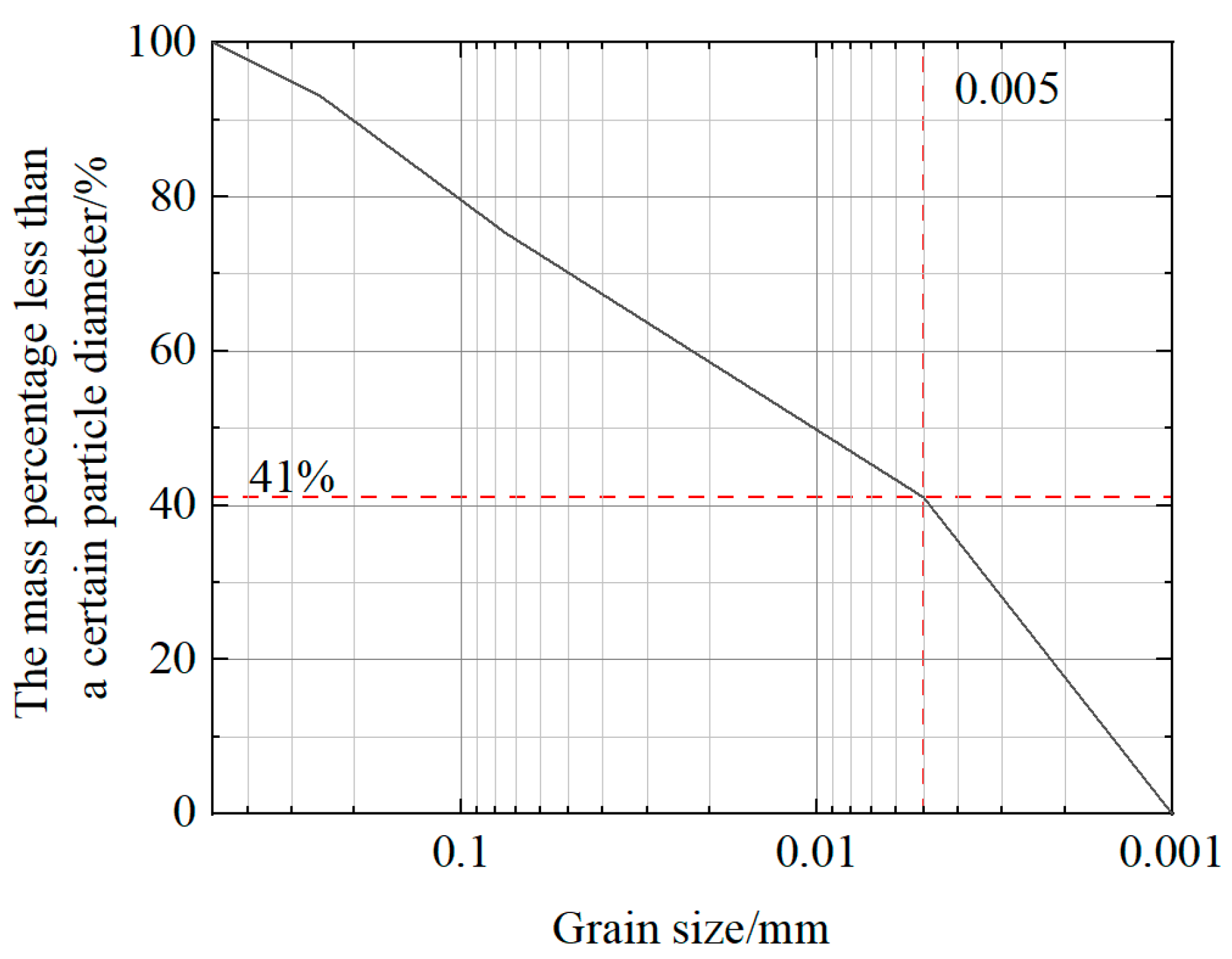
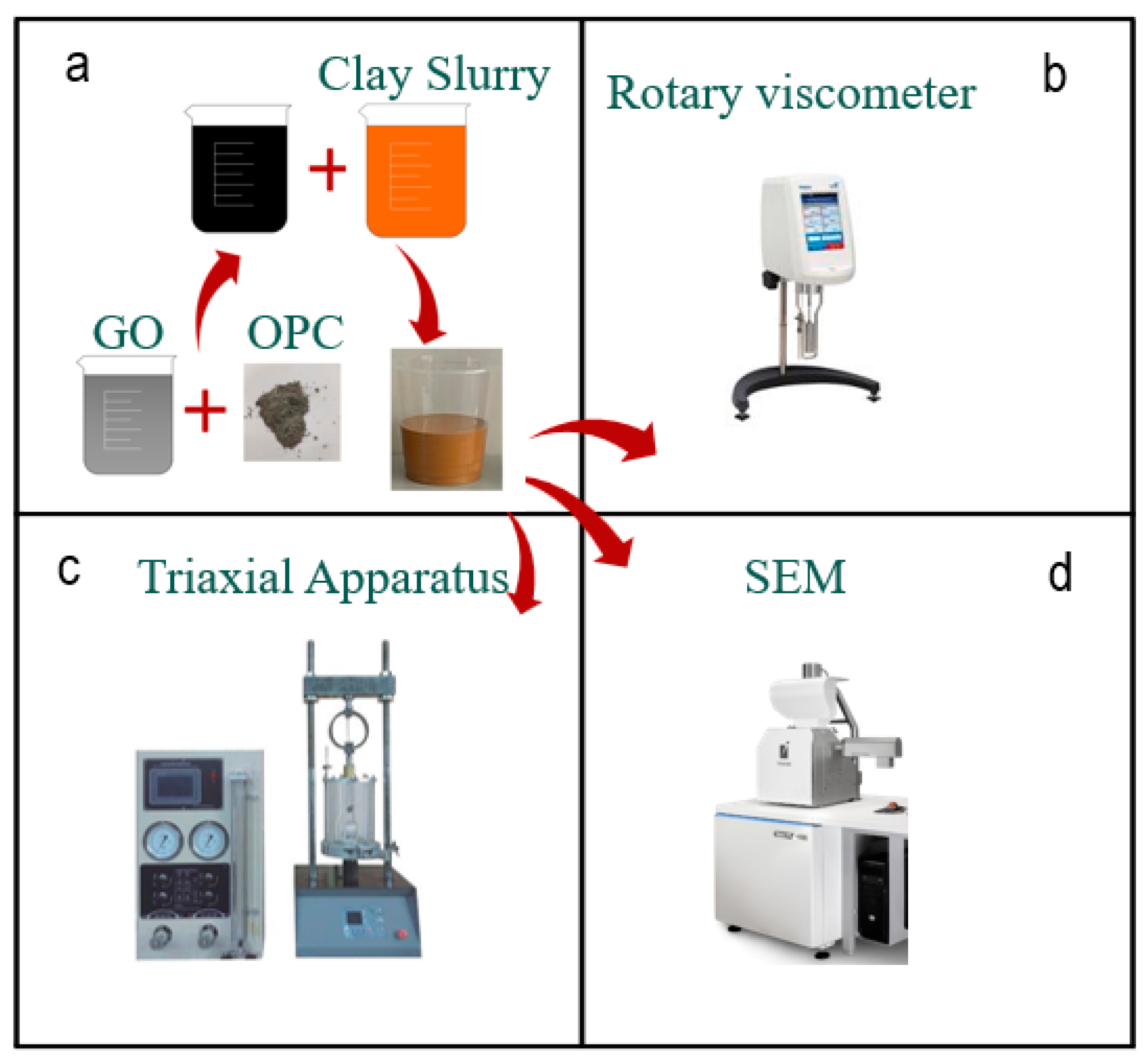
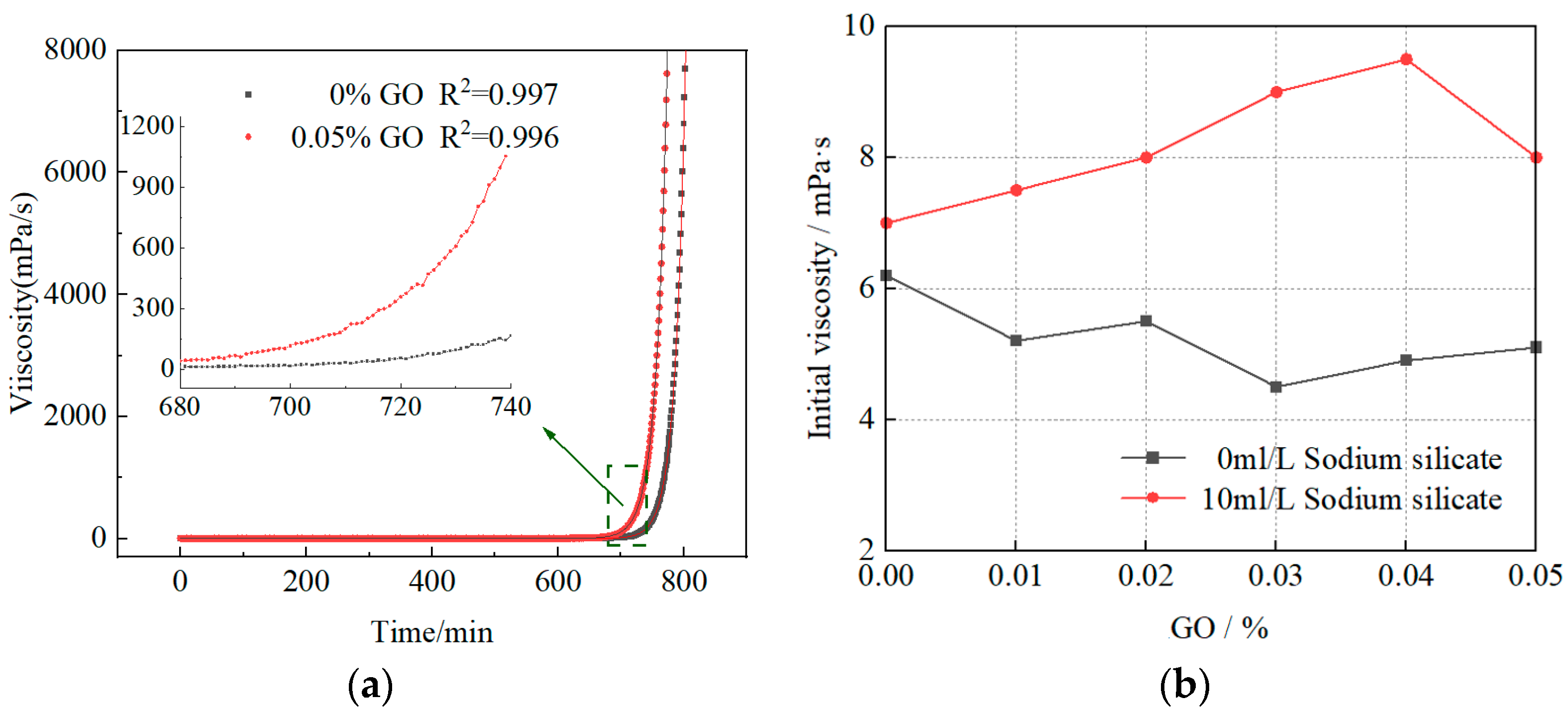
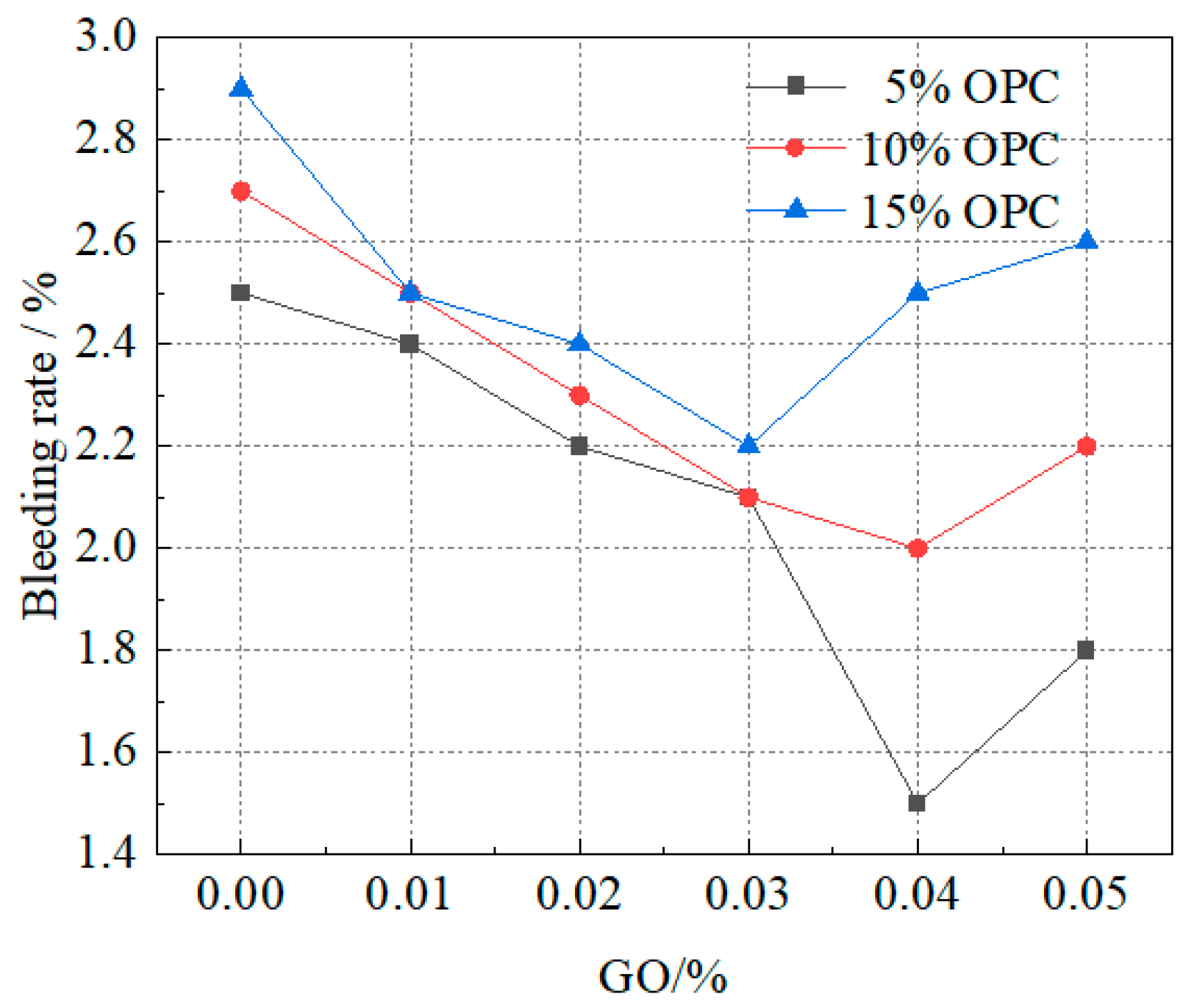
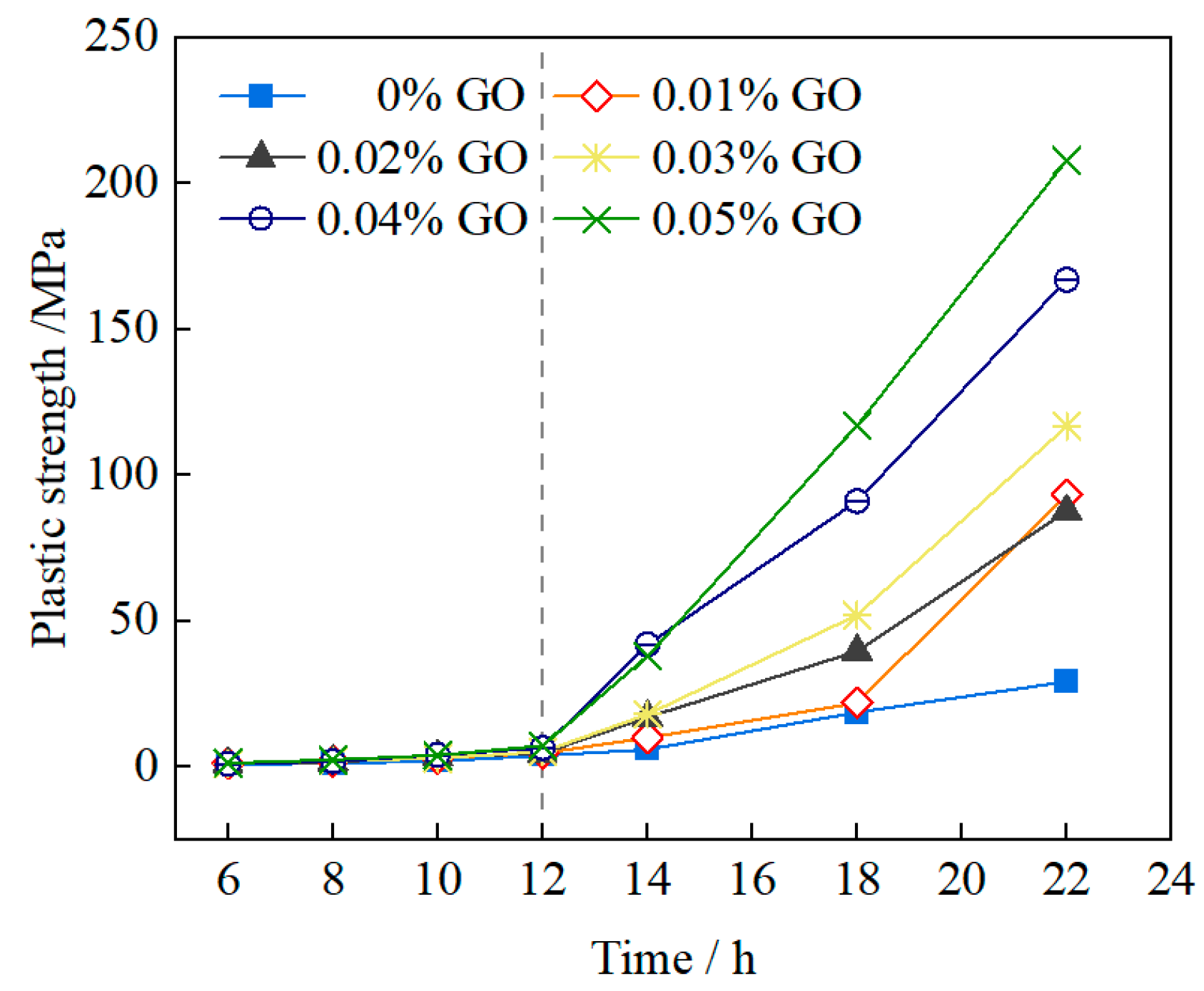
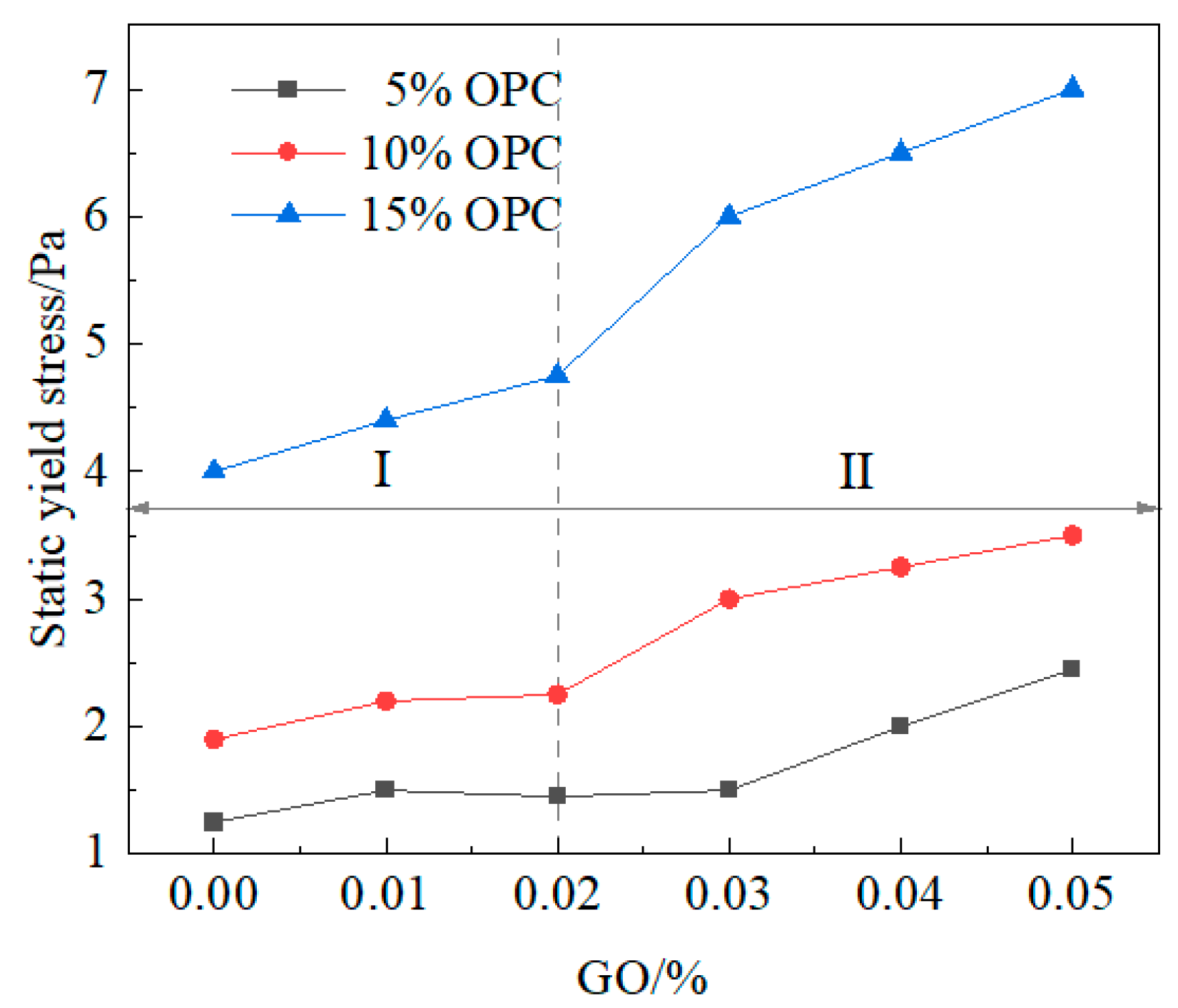






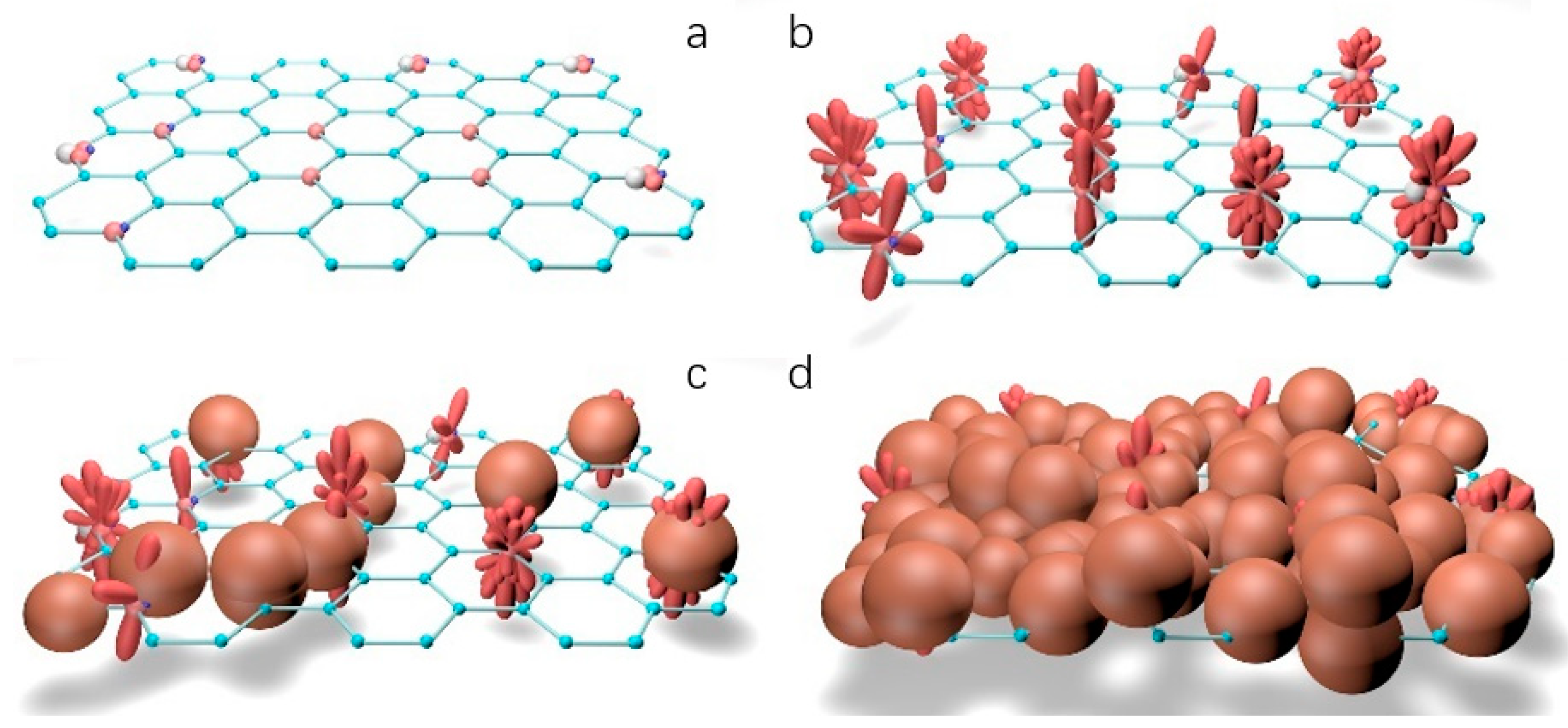
| Chemical Composition | SiO2 | Al2O3 | Fe2O3 | CaO | MgO | SO2 |
|---|---|---|---|---|---|---|
| Value/% | 21.32 | 4.31 | 3.38 | 61.26 | 2.47 | 2.55 |
| Property | Water Content (%) | Plastic Limit (%) | Liquid Limit (%) | Plasticity Index | Liquid Index |
|---|---|---|---|---|---|
| Value | 3.7 | 24.2 | 41.1 | 17.2 | −1.19 |
Disclaimer/Publisher’s Note: The statements, opinions and data contained in all publications are solely those of the individual author(s) and contributor(s) and not of MDPI and/or the editor(s). MDPI and/or the editor(s) disclaim responsibility for any injury to people or property resulting from any ideas, methods, instructions or products referred to in the content. |
© 2023 by the authors. Licensee MDPI, Basel, Switzerland. This article is an open access article distributed under the terms and conditions of the Creative Commons Attribution (CC BY) license (https://creativecommons.org/licenses/by/4.0/).
Share and Cite
Liu, S.; Sun, J.; Zhang, J.; Xie, Z.; Yu, Z. Effect of Graphene Oxide on the Mechanical Property and Microstructure of Clay-Cement Slurry. Materials 2023, 16, 4294. https://doi.org/10.3390/ma16124294
Liu S, Sun J, Zhang J, Xie Z, Yu Z. Effect of Graphene Oxide on the Mechanical Property and Microstructure of Clay-Cement Slurry. Materials. 2023; 16(12):4294. https://doi.org/10.3390/ma16124294
Chicago/Turabian StyleLiu, Shujie, Jinze Sun, Jiwei Zhang, Zuodong Xie, and Zhijie Yu. 2023. "Effect of Graphene Oxide on the Mechanical Property and Microstructure of Clay-Cement Slurry" Materials 16, no. 12: 4294. https://doi.org/10.3390/ma16124294
APA StyleLiu, S., Sun, J., Zhang, J., Xie, Z., & Yu, Z. (2023). Effect of Graphene Oxide on the Mechanical Property and Microstructure of Clay-Cement Slurry. Materials, 16(12), 4294. https://doi.org/10.3390/ma16124294







